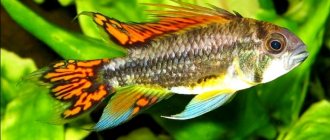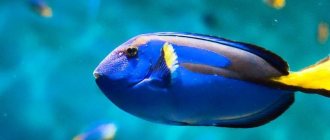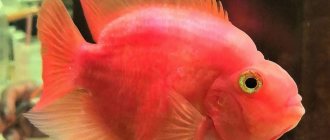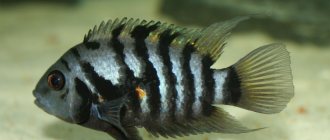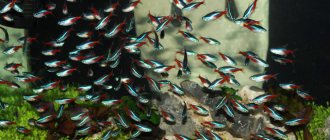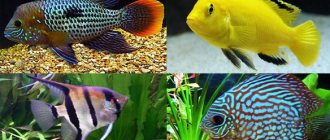by fisher November 25, 2014 0 Comments
Family: Cichlids
African cichlids
Princess of Burundi, by this name, this popular fish is known to most aquarium lovers. In nature, it lives in Lake Tanganyika near the city of Kasanga in southwestern Tanzania. The species united several geographical races of the same species, differing slightly in appearance. At first, two such races were even classified as different species, Neolamprologus pulcher and Neolamprologus brichardi. But later revisions of the genus established that these are representatives of the same species. Therefore, according to the existing rules of scientific classification, the species is correctly called Neolamprologus pulcher, since this name was given to the species earlier.
The second species name was given in honor of Pierre Brichard, a Belgian ichthyologist who was involved in the capture and export of Tanganyin cichlids. Small external differences: a black stripe stretching from the eyes to the gill covers and a yellow spot located slightly above this stripe inherent in N. brichardi and absent in N. pulcher are due to the isolated habitats of natural populations.
Princess of Burundi
The typical habitats of this species are rocky biotopes, while sandy underwater plains separating areas of the bottom with piles of rocks are an insurmountable obstacle for many species of fish. Hence the appearance of a large number of geographical races of fish living in the lake. Moreover, the farther the habitats of these populations are located from each other, the more external differences they can have. Like other cichlids living in Lake Tanganyika, the Princess of Burundi, depending on its habitat, shows significant variability. The species was found both in surface layers and at considerable depth. As a rule, fish of this species live at depths of 7 meters and deeper.
Princess of Burundi - description of the species
The appearance of the Princess of Burundi corresponds to its name; it is an elegant fish with an elongated, slightly laterally flattened body and elongated unpaired fins. The main body color is beige-pink with small yellow patches on the body and fins; a dark intermittent stripe runs from the eye to the edge of the gill cover. Above which, closer to the upper edge of the gill cover, there is a bright yellow-orange spot. A characteristic feature of this cichlid is the highly elongated tips of the dorsal and anal fins, with orange strokes and bright blue with a white border. The lyre-shaped caudal fin also has elongated projections at the ends.
Mature males are usually larger than females, the ends of their dorsal and caudal legs are more elongated. In nature, adult specimens grow up to 10-13 cm, and in aquariums they can be even larger - up to 15 cm, the usual size of an adult specimen is 7-10 cm. The average life expectancy of the Princess of Burundi in an aquarium is 8-10 years.
Feeding
In nature, it feeds on phyto and zooplankton, algae growing on rocks and insects. In the aquarium they eat all types of artificial, live and frozen food.
The basis of nutrition may well be high-quality food for African cichlids, containing all their necessary elements. And additionally feed with live food: artemia, coretra, gammarus and others.
Bloodworms and tubifex should also be avoided or given minimally, as they often lead to disruptions in the gastrointestinal tract of Africans.
Princess of Burundi - biological features
Unlike other lamprologus, Neolamprologus pulcher unite in huge schools consisting of several hundred individuals, and such schools can consist of several generations of fish with a predominance of juveniles of previous broods related by blood. The size of the flock has a positive effect on the survival of individual specimens. Burundi princesses are unusual in their behavior; they are perhaps the only species of fish living in Africa that collectively care for their offspring.
Neolamprologus Brichardi at the entrance to the shelter
In such a community there is a strict social hierarchy. At the highest level there is a small group of producers, usually their number does not exceed ten. During the breeding season, cichlids form permanent social groups consisting of a spawning pair and several helper relatives. The spawners begin to actively reproduce; spawning occurs every 20 days in various caves and rock crevices. In addition to the spawners, helper individuals take part in the further care of the eggs, larvae and fry that have begun to swim. Usually these are grown-up fry of the 4-5th age group, mostly future females. Helpers occupy the second rung of the pack's hierarchical ladder. The next group in the hierarchy consists of growing juveniles up to the fifth age group. Upon reaching 3-4 months of age, they leave the spawning site of their parents, joining the largest part of the flock. This is the most “disenfranchised” category, not even having its own territory. They usually stay 1-2 meters above the spawning grounds of their spawners, an area that is periodically visited by predators.
The best breeding result of Princesses of Burundi (assessed by clutch size and survival rate of fry) was achieved if the spawning pair had such helpers. At the same time, the amount of eggs laid decreases, which indicates the ability of females to reduce their productivity under favorable conditions. When breeders and their helpers take care of the offspring, the risk of death of the fry is significantly reduced. It should be noted that at high population densities the phenomenon of decreased fertility is not observed.
How does a fish develop?
The larvae hatch from the eggs on the third day. After 8-9 days they turn into fry. These young cichlids should be fed live dust. It often happens that producers begin to take care not only of their own offspring, but also of others of the same species. In the first two days, the fry stay strictly near their mother. Then they begin to sail to bright places in search of food. Approximately 7 days after hatching, their eyes turn blue, and after 14, a white edge appears on the fins.
Parents care for the fry for two weeks. After this, the young fish begin an independent life.
Keeping the Princess of Burundi in an aquarium
Individuals or a pair of fish can live in a relatively small aquarium (30 liters per pair), but an aquarium of more than 200 liters is required to exhibit the natural behavior of a group of fish during the breeding season. The aquarium is set up in the style of the natural biotope of Lake Tanganyika; it should contain piles of stones, with caves and crevices in them. It is preferable to use river sand as soil. The conditions of detention are as follows: water temperature 25-26 degrees; acid index (pH: 8.6); hardness - 8-20°.
Group of Neolamprologus Brichardi in an aquarium
Reviews
The fish is interesting and active. Originally colored and actively reproducing. Sensitive to conditions of detention.
Half of aquarists find princesses peace-loving, half - quarrelsome. The tightness of the container and the lack of shelters take their toll. The individual character of the fish is noted.
Reproduction of the Princess of Burundi in an aquarium
Neolamprologus pulcher are typical representatives of cichlids with a substrate type of spawning. The eggs are usually laid on the ceiling of a cave or in a rock crevice. In the aquarium, the Princess of Burundi reproduces relatively easily. The best result is achieved by randomly forming a pair in a group consisting of 6-10 individuals raised from fry.
Neolamprologus Brichardi with fry
As a rule, for reproduction, a pair of fish retires from the main group. A male can spawn with one or several females. A female ready for spawning develops a long genital papilla. Spawning is portioned; the female lays up to 30 eggs at one time. In total, up to 200 eggs (usually less) can be laid on the wall or ceiling of the cave. A pair of fish guards the area where the clutch is located. After spawning, the female remains with the eggs, and the male guards the surrounding territory. After 2-3 days, larvae appear from the eggs, which after 7 days begin to swim freely. The fry are quite large, so Artemia nauplii can immediately serve as starter food for them. The fry grow slowly. But caring for the offspring continues for quite a long time. Fish mature at the age of 8-10 months. The whole group protects fry of different ages. In this way, several generations can live together. In case of limited space, females begin to lay fewer eggs or may even eat the fry.
Recommendations for choosing and equipping an aquarium
Since the fish is a schooling fish, it is recommended to purchase several individuals at once. It can be one male and 5-7 females or 2-3 males and 10-20 females. If you bought a couple of fish, a sixty-liter aquarium is enough. For a male and several females, the minimum amount of water is 150 liters.
The more individuals there are, the larger the aquarium should be.
The fish are very mobile and prone to jumping out, so it is advisable to purchase a closed structure or cover an ordinary aquarium with a homemade lid.
Fish look for a place to spawn in caves under rocks, so rocky castles should be provided at the bottom of the aquarium. The soil should be rocky. Algae must be well fixed in the soil, as fish like to dig up plants.
Vallisneria or other bushy algae can be planted in separate pots, which will protect the plants from being dug up. If this is not possible, the algae roots should be covered with large stones.
The aquarium should be maintained at a certain temperature, which should be +22-28°C. Exceeding the temperature leads to a deterioration in the condition of the fish, so in the summer you should add a small portion of chilled water to the aquarium daily.
In winter, it is difficult to achieve the required water levels without additional heating, so you cannot do without purchasing a heater. A thermometer will help you control the water temperature - another accessory necessary for arranging an aquarium.
The acidity of the water should be in the range of 7-8.5 units; you can measure its value using a special tester, available for sale in any pet store. Since the Princess of Burundi belongs to freshwater inhabitants, when purchasing a tester, pay attention to this indicator.
Testing is carried out weekly after adding fresh water to the aquarium. 5 ml of aquarium water is taken into a test tube, then the required amount of solution is dripped according to the instructions, closed with a lid and shaken well. The solution comes with a color scale, which can be used to check the acidity of the water. The color of the liquid in the test tube is compared with the scale.
Decryption results:
- 6.0-6.8 – acidic environment;
- 7.0-8.5 is a satisfactory indicator for Burundi fish;
- over 8.6 – too alkaline environment.
Water from the test tube should not be poured into the aquarium; it should be disposed of by throwing it down the drain. It is recommended to wash the test tube and cap thoroughly.
Based on the research results, conclusions are drawn about the acidity of the water and products are purchased that increase or decrease the pH. After adding them to the water, the acidity of the water is re-monitored. The procedure is repeated until the indicator approaches the required value.
There are immersion testers on sale; their cost is much higher than regular ones, but they are more convenient to use. A budget meter can be called a pH meter, which is attached to the walls of the aquarium using suction cups and resembles an electronic temperature sensor. More accurate measurements are made using a stationary device equipped with an electrode probe.
Tips for working with chemicals
When testing, you must follow a number of rules:
- When working with water testers, you should be careful, as the acids included in the composition can cause chemical burns.
- If an aquarium is purchased for a child, you should not trust the child with such an important procedure as testing the acidity of the water. Testing can be carried out by adults or school-aged children under parental supervision.
- If you come into contact with chemicals on your skin while working with chemicals, you should immediately rinse the area with water.
- Testing should not be performed over a wooden surface. Drops of chemicals that fall on the table burn through it.
- Before testing, you should carefully study the instructions and strictly follow them.
Hardness index
Hardness is a fairly important indicator of water; it should be taken into account along with acidity and temperature. Hardness varies, for example, tap water has an indicator of 20 units, from 0 to 4 - the water is too soft, from 5 to 8 - soft, if the indicator falls within the range from 9 to 16 - the water has medium hardness, from 17 to 32 units means hard water, more than 33 means excessively hard water.
For the Princess of Burundi, the optimal stiffness is between 8-20°. It must be taken into account that the indicator differs for each type of fish, therefore, when different species are adjacent, it is necessary to choose the most acceptable option for all inhabitants.
To measure hardness, you can use test strips, chemical reagents, and instruments (salt meter or TDS meter). The simplest method is using the properties of laundry soap. In hard water, soap lathers very poorly, but in soft water it quickly forms foam.
If it is necessary to increase the hardness, boil the water in an enamel bowl, then let it settle and drain 2/3. The remaining part with calcium salts is poured in small portions into the aquarium, constantly monitoring the hardness indicator. Shell stone, marble or limestone rocks improve hardness well.
If it is necessary to reduce the hardness level, distilled water is added to the aquarium. You can use special water filters or pass water through peat. A peat bottom is an excellent solution for a spawning aquarium, where water hardness should be reduced.
Compatibility with other types
Princess of Burundi is a territorial species. Males protect their territory from individuals of their own and foreign species. This applies to a greater extent to males of other species, but there are males that show aggression towards their relatives. The Princess of Burundi is not a fish for the general aquarium; it is territorial and quite aggressive, especially during the period of raising fry. Therefore, the best option for keeping it is a species aquarium. In large aquariums, Neolamprologus pulcher can live with other medium and small Tanganyin cichlids, occupying different niches.
Diseases
Princesses of Burundi are sensitive to water parameters. If there are behavioral disturbances, swimming in the upper part of the aquarium and gasping for air, change the water, increase aeration and filtration. This is how a lack of oxygen in a crowded aquarium or nitrate poisoning manifests itself.
Conduct tests for recommended water parameters. Bring the parameters back to normal. If symptoms persist, begin diagnosis and treatment.
Ichthyophthyriosis is a parasitic infection of ciliates. Introduced through live food or new inhabitants. It appears as white bumps on the skin (“semolina”). Treat with Tetra Contralck according to the attached instructions.
Bacterial infections manifest themselves as mucus, swelling of scales, and spots on the skin. Treatments include Tetra General Tonic (external infection), Sera baktopur direct and Sera bakto Tabs (internal infection).
Fungal infections are characterized by a “cotton wool” appearance on the skin. Most can be treated with special medications.


